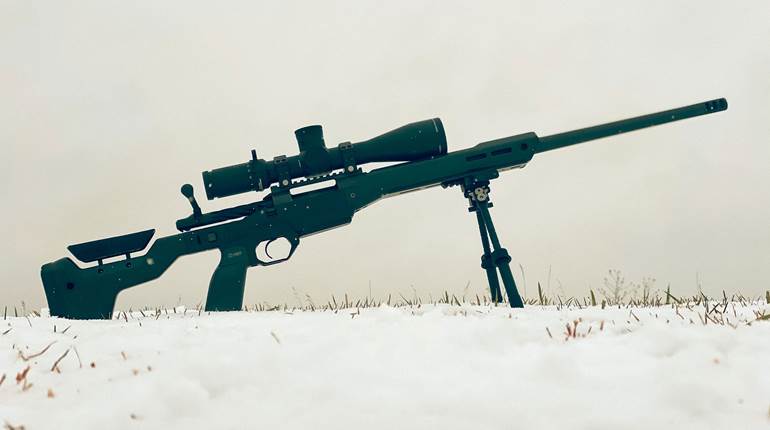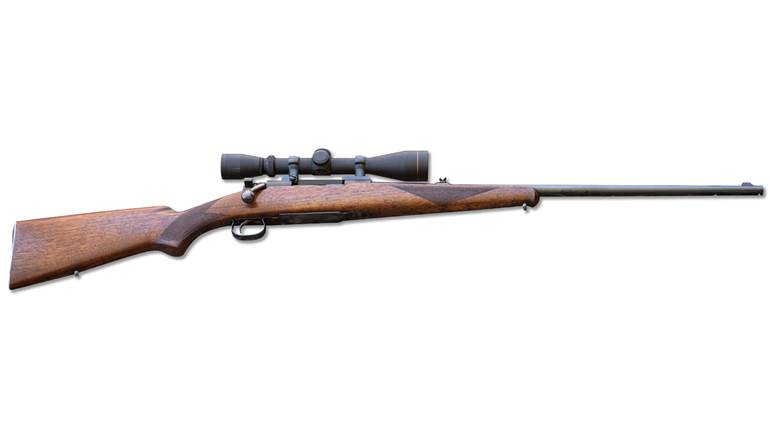
In 1919, Winchester vice president Edwin Pugsley brilliantly coined the marketing slogan “The Gun That Won The West.” He was referring to the Winchester Model 1873 lever action, which–ironically enough–was on the verge of being discontinued, as by that time, the West had already been won. However, Winchester was riding to newfound fame with an even more popular and ultimately more prolific lever action, one that can be credited as having helped settle the West.
That gun was the Winchester Model 1894, the rifle that ushered in the age of smokeless powder, longer-range shots at ever more wary game animals and which is credited with having harvested more deer than any other sporting arm in America. Unlike the Winchester '73, with its toggle-link action that dated from the Henry Rifle in 1860, the Winchester 94 was the latest product from the ever-fertile mind of firearms designer John Moses Browning, who had previously weaned Winchester away from the blackpowder-era 1873 and 1876 models and for the more durable designs of the model 1886 and 1892 lever actions.
But the Model 1894 was a different lever action entirely, even though it retained the familiar side-loading, tubular-magazine look of earlier Winchesters. Winchester Repeating Firearms paid Browning $15,000–the same amount he had previously received for his Model 1886 and 1892 patents–for exclusive rights to manufacture the Model 94. That was a lot of money back then, but of course it was worth it, for the Model 94 was the first repeating rifle to be adapted to smokeless powder cartridges, specifically the .25-35 Winchester Center Fire and the .30 WCF, which came to be known as the .30-30 Win.
 The receiver of the Model 94 features a hinged floor plate that pivoted down when the action was opened, revealing a simplistic but sturdy inner mechanism.
The receiver of the Model 94 features a hinged floor plate that pivoted down when the action was opened, revealing a simplistic but sturdy inner mechanism.
However, both of these smokeless-powder trendsetters didn’t emerge until 1895–one year after the Model 94's introduction. The delay was caused by glitches in producing the Model 94's much-touted nickel-steel “smokeless-powder” barrels. Thus, Winchester’s first smokeless-powder repeater was initially only available in two older blackpowder cartridges, the .32-40 Winchester (also known as the .32-40 Ballard, as it was developed by Charles H. Ballard in 1884 as a target round for his rifles) and the .38-55 Winchester (also developed by Ballard, and as a target round in 1875).
In 1895, with their smokeless-powder metallurgy issues solved, the Winchester Model 1894 came into its own. The nickel-steel barrels notwithstanding, the design of the action itself was more than adequate to handle the new smokeless-powder pressures. As the lever was closed, a thick, solid-steel rod slid up in front of the hammer and locked securely behind the closed bolt, thus providing a greater margin of safety to the shooter, a major selling point in those transition years between blackpowder and smokeless cartridges.
Also unique to the Model 94 was its receiver’s hinged floor plate that pivoted down when the action was opened, revealing a simplistic but sturdy inner mechanism. Two basic versions of the Model 94 were offered, a 20" barreled saddle-ring carbine and a 26" round or octagon-barreled rifle. Later 24" barrels were standard for certain calibers such as the .32 Winchester Special.
 The Model 94 carbine was favored by many law enforcement agencies. This carbine was used by the North West Railroad Police during the 1920’s and 30’s. Note the blood-etched receiver.
The Model 94 carbine was favored by many law enforcement agencies. This carbine was used by the North West Railroad Police during the 1920’s and 30’s. Note the blood-etched receiver.
In addition, special order Model 94 options were available up through the first half of the 20th century, including half-round, half-octagon barrels, take-down versions, special engravings, checkering patterns and a variety of barrel lengths, including rare “Baby Carbines” (since dubbed ‘Trappers’ by collectors) that sported 14", 15" and 16" barrels. The overall gun itself was ruggedly handsome and quickly became a favored firearm not only for hunters, but for ranchers and farmers as well.
And because the Model 94's large trigger guard could readily accommodate gloved hands, it became the rifle and carbine of choice during the 1897 Alaskan Gold Rush, resulting in the Winchester 94 being christened “The Klondike Model” during those early years. Small wonder that over time it came to epitomize north woods deer camps, long trail rides in saddle scabbards and became a regular fixture in many a pickup truck’s rear window gun rack.
Likewise, numerous law enforcement agencies, including various railroad police, the Texas Rangers and New York State Troopers, added the Winchester 94 to their gun racks. And during both World War I and World War II, approximately 1,800 special ordinance-marked Model 94 carbines were issued to U.S. troops stationed along the Mexican and Canadian borders, as well as to home guard units and members of the Army Signal Corps. But as good as it was, over the years, a number of changes took place with the Model 94.
 This 16” barreled Winchester 94 “Trapper” was shipped from the factory on August 27, 1929. These Special Short Carbines, as the factory called them, are exceedingly rare, were never cataloged, and were ultimately discontinued in 1933.
This 16” barreled Winchester 94 “Trapper” was shipped from the factory on August 27, 1929. These Special Short Carbines, as the factory called them, are exceedingly rare, were never cataloged, and were ultimately discontinued in 1933.
In 1924, the rifle was discontinued and the saddle ring was eliminated on the carbine in 1932, although it still could be special ordered up until 1942. Interestingly, carbines made without saddle rings during the early years of the 20th century are often referred to as “eastern carbines.” In 1951, the longer wood of the carbine’s forearm was shortened. But far more dramatically, in 1964, due to what is now acknowledged to have been an ill-advised executive decision, manufacturing procedures were modified to reduce costs which included replacing the milled steel loading gate with one of pressed metal and cheapening many of the internal parts.
As a result, the once-solid deer rifle now “rattled.” Thankfully, answering consumer outcries, Winchester gradually brought the Model 94 back to its former solid construction starting in 1967. Nonetheless, that chapter in the Model 94's history has provided today’s collectors with the designations of “Pre-64” and “Post-64” Winchesters, with used Pre-64 guns commanding a premium on today’s market.
Also adding to the collectable nature of the Winchester 94 was its long line of commemorative models, beginning with the 1964 Wyoming Diamond Jubilee, and recently including the 2016 Model 94 150th Year Commemorative, which actually encompasses the beginning of the Model 1866. Naturally, after such a long lifespan, there have also been many manufacturing tweaks and upgrades to the Model 94. In 1981, “side eject” was added, so that for the first time it became possible to mount a scope directly over the receiver rather than off to the side.
 The Model 94 is the perfect gun for fast shots at close range on medium-sized game. The author dropped this running wild boar with a single shot from his "pre-’64" .30-30 Win. carbine.
The Model 94 is the perfect gun for fast shots at close range on medium-sized game. The author dropped this running wild boar with a single shot from his "pre-’64" .30-30 Win. carbine.
During the 80s, Winchester Repeating Arms went through a series of financial straits, eventually becoming U.S. Repeating Arms Company and, for a while, the gun was manufactured under that name. During the 1990s, the Model 94’s traditional half-cock was replaced by a trigger-block safety and a trigger-return spring, along with an unsightly dished-out, push-button safety that thankfully was replaced in 2003 by the current tang-mounted safety.
The most dramatic change, however, came with the closing of Winchester’s historic Hartford, Conn., factory in 2006 due to continuing financial struggles, which marked the end of the U.S.-made Model 94 (and resulted in a buying frenzy for the remaining American-made carbines that were still on dealer’s shelves). Today, after a brief hiatus, the Model 94 has been resurrected by Fabrique Nationale (FN) through its Browning Arms Company subsidiary, which has become the sole owner of Winchester Repeating Arms.
As a result, Miroku in Japan is currently making the legendary lever action with a quality of workmanship that actually rivals the guns of yesteryear. Expanding dramatically from its original carbine and rifle configurations, today, the Model 94 is also available as a Deluxe Sporting Rifle and Short Rifle, a Trails End Takedown version, a Sporter and as 125th Anniversary gold embellished and engraved Anniversary Custom and High Grade model. In addition, special offerings of limited editions and commemoratives are periodically introduced to satisfy an ever-present cadre of collectors.
 Winchester has produced numerous commemoratives over the last 50 years, including this Oliver Winchester 200th Anniversary model in 2016. Photo courtesy of Winchester Repeating Firearms.
Winchester has produced numerous commemoratives over the last 50 years, including this Oliver Winchester 200th Anniversary model in 2016. Photo courtesy of Winchester Repeating Firearms.
And although it was once known generically as “a thirty-thirty” due to the proclivity of the carbine in that caliber, today the Model 94, while still being chambered in its original .25-35 Win., .30-30 Win. and .38-55 Win. calibers, is also available in the turn-of-the-last-century’s .32 Win. Spl. and in the more modern .450 Marlin, depending on the model selected.
To date, there have been more than seven and a half million Model 94s made, and it is fairly safe to say that there are more of them being carried in the forests and fields every autumn than there are hanging on walls as décor. Indeed, the Winchester 94 has come to epitomize the classic short range deer and black bear rifle. Whether scoped or open sighted, carried on horseback or in an ATV, it is now well into its third century as one of America’s most legendary and reliable lever actions.

















![Winchester Comm[94]](/media/1mleusmd/winchester-comm-94.jpg?anchor=center&mode=crop&width=770&height=430&rnd=134090756537800000&quality=60)
![Winchester Comm[94]](/media/1mleusmd/winchester-comm-94.jpg?anchor=center&mode=crop&width=150&height=150&rnd=134090756537800000&quality=60)


















